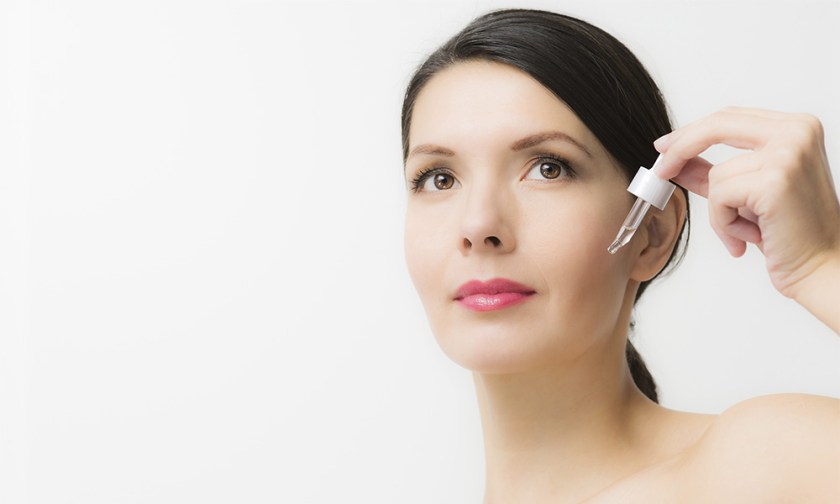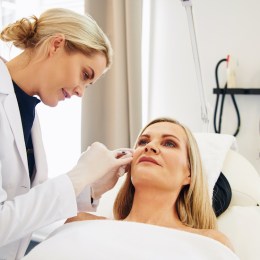Skin serums have become the wunderkinds of the topical skincare industry over the past decade. But there are hundreds of ingredients to choose from, and a vast array of textures and promises. Clients will be looking to you for guidance. Marie Enna-Cocciolone helps you navigate the maze for best client outcomes.
Serums vary from light-textured formulas that sink straight into the skin leaving no residue, gel consistencies that leave a slight but not occlusive layer and then those resembling light moisturisers ot even creams.
So what to advise a client for their skin type and concern? Generally speaking, I would recommend the following ingredients and textures for these skin types:
Dry: Oil/lipid-based products to nourish and repair the protective barrier. Dehydrated: Humectant (moisture- retaining) formulas such as those containing hyaluronic acid (HA).
Flaky: These are usually dry complexions and respond best if a light enzyme peel (pomegranate or pumpkin) is used first to lift off the redundant cells and then lipid- based serums to nourish.
Dull-looking: Skin that needs to be stimulated. You can’t go past a pick-me- up professional peel, then at-home use of serums containing vitamin C and vitamin B3 (niacinamide).
Excessively oily: These skins need to be rebalanced. Products should not contain oil but instead, in most cases, a lotion-like texture. Use ingredients such as B3 and retinol (vitamin A) to rebalance oil production, not strip the skin.
Mature: Lines, wrinkles and loss of firmness are due to loss of collagen, elastin and HA, key proteins required for youthful- looking skin. There are many ingredients to stimulate collagen synthesis: golden oldies like vitamin C and retinol. Newer peptide technology not only encourages growth but also the quality and the lifespan of the collagen. Look for ingredients such as trylagen, klotho and colhibin.
Sun damaged/weathered: These skins benefit from a course of, say, in-clinic peels, skin needling or LED phototherapy as a starter. At home, make sure clients are using, at an absolute minimum, vitamin C in the morning and vitamin A at night.
Pigmented: Use of serums containing vitamin C, B3, retinol and peptides especially for lightening and brightening is advised, plus a skin needling device to infuse the serums and break down the pigmentation faster. It’s advised that clients start with in-clinic needling and maintain results at home. Needless to say, they must use an SPF 30+, zinc-based, broad spectrum sunscreen rain, hail or shine!
Acne/rosacea: Products whose ingredients have a calming, soothing and anti- inflammatory effect are musts here, and less is best. Use retinol, niacinamide, HA, Symglucan and micronised zinc.
Congestion, blackheads, large pores. Depending on the client’s skin type, you may choose some gentle AHAs and BHA. But their skin must be very clean (ideally using a cleaner with zeolites) and a regular professional light peel or microdermabrasion makes a big difference.
Diffuse redness, with broken capillaries. Calming and soothing is key: ingredients like aloe vera, oat kernel, comfrey, mallow, bisabolol are perfect, with vitamins C, F and K help to strengthen capillary walls
Extremely sensitised: These skins needs re-balancing and strengthening and, so, use of retinol. They should start with very low doses to strengthen and rebuild fragile, volatile skin, and also biomimetic peptides that imitate the biological conditions found in healthy skin.
TOP TIPS
Skincare today is based on active ingredients with proven delivery systems. Depending on the percentage of active ingredienst, it can trigger a cellular change. It’s difficult for consumers to know right from wrong.
You should encourage clients – and clients to advise their friends – that the best first step is to have a professional skin analysis by a therapist before buying serums, and ideally not to buy at random from department stores, supermarkets and chemists.
They need to understand what the active ingredients of a product are, in what percentages and what these ingredients do before applying anything to their skin – or they can do themselves damage; at the very least, waste money.
In most cases, serums should be applied after cleansing/toning and before moisturisers/sunscreen. Serums can be layered but the key here is to understand the potency of the actives in each product to ensure the skin isn’t over-stimulated.
When layering, start with water consistency-type products, then gels, lotions, cream and oils, in that order.
Some oil-based serums maybe too oily for the day and so are best kept for night regimes. Some ingredients are photo-sensitive, such as retinol/vitamin A. These are best used at night, too.
Serums generally shouldn’t be used alone (ie. without moisturisers) unless the serum is in a lipid lotion/cream base and it offers enough skin comfort and hydration.
There is always a risk when mixing different brands of serums. For instance, O Cosmedics serums have a liquid crystal base and delivery system. Used with other serums it may block out their ability to penetrate the skin, especially if used in the wrong order.
 Marie Enna-Cocciolone is CEO and founder of Inskin Cosmedics and O Cosmedics.
Marie Enna-Cocciolone is CEO and founder of Inskin Cosmedics and O Cosmedics.




